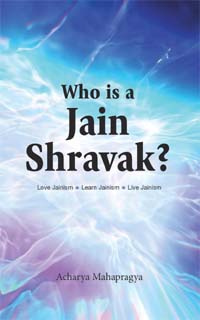BhagawanMahavira propounded two types of religion -
- Anagaardharm- Religion for a monk
- Agaardharm- Religion for a householder
In ShravakSambodh, the emphasis is laid on agaar dharma, thus, anagaardharm is not discussed in detail. The religion followed by a grihastha shravak (householder) is put into a separate category known as vrataavrati or dharmaadharmi.
Yaha vrataavrati dharmaadharmi ki shreni, aadhyaatmik aarohan hit hai nishremi,
is shreni mein jo hi maanav aate hain,ve sharmanopaasak shravak kahalaate hain.
BhagawanMahavira categorized all living beings into three-
- Avrati (non-abstinent)
- Vrataavrati (partially abstinent)
- Mahaavrati (abstinent)
Avrati(Non-Abstinent)
Avrati is a person who remains completely free. Only two types of souls can remain completely free, either emancipated or non-abstinent. An emancipated soul has no bondage or karma. A non-abstinent soul also does not have any bondage in terms of discipline. Such souls travel, eat, sleep, and do anything they want. They do not follow any discipline or vows. So, both the souls are free. A parallel can be drawn between them only from this perspective.
Once a financially deprived scholar entered the king's assembly and stood arrogantly. Everybody thought - How stupid he is! He should at least greet the king. The king and the people both felt embarrassed. One of the assembly members asked him, 'Why are you standing so arrogantly? At least salute the king.'
Scholar: 'I salute poverty only.' Assembly member: 'Why only to poverty?'The scholar explained the reason in a Sanskrit verse -
re daaridiya! namastubhyam, siddhoham tvatprasaadatah,
sarvaanaham cha pashyami, mam na pashyati kaschana.i.e. Poverty! I salute you. I have become liberated (siddha) because of your grace. The characteristic of siddha is that he looks at everybody, but nobody looks at him. Similarly, I look at everybody, but nobody looks at me. You are Majesty! Tell me, am I liberated or not?' For this reason, I greet poverty only. His rationale was that the etiquette of greeting does not apply to him. He is free from all such formalities because he is poor.
In the same way liberated souls and avrati(non-abstinent) can be compared. A non-abstinent person is free from spiritual practices such as vows and the emancipated soul is also free from any kind of such spiritual activities. Everyone else between these two levels always remain in vows. Therefore, the first is the category of avrati which are free from bondage of discipline.
Vrataavrati(Partial Renunciation)
Vrataavrati is the second category where the person lives with discipline and moves towards liberation. Such a person is known as a shravak and is at the fifth stage of gunasthaan (spiritual development). Though the householder does not accept the vows completely, he undertakes partial vows with reference to the three-fold activities of mind, speech, and body for his survival. For example, a householder cannot take the complete vow of abstaining from injury to one-sensed living beings, such as vegetables for his survival.
This category is the first step towards moksha by accepting the vows partially. Agaardharm is the class of vrataavrati. Such people are neither completely vrati(monk) nor completely avrati(non-abstinent).
Mahaavrati(Complete Renunciation)
The population of India runs into billions, but only a fraction of these people falls into the category of mahaavrati because such life is full of restrictions. A Mahaavrati accepts the vows entirely with no exceptions. They not only preach, but also practice five mahaavrats(great vows) of non-violence, truth, non-stealing, celibacy, and non-possession throughout their life. They do not consume anything before sunrise and after sunset. Their life is full of restraint.
There are many avrati while number of vrataavrati is small and of mahaavrati is even smaller. It is important to increase at least the numbers of vrataavrati to make them follow the path of spirituality.
Meaning of Vow
Let us first understand the meaning of vrat(vow). Vrat means to close the door of incoming karma and to gain control over desires. In other words, vrat means to discipline the desires, ambitions, and non-restraint. Some examples of restraints are to limit the activities we do, limit the number of items we eat, limit the number of products we use. Such discipline, control or regulation of desires is known as vrat.
The Problem Caused by Non-Abstinence
In Sutrakritanga Sutra, we find a description on:
- Adharm(State of non-righteousness)
- Dharmaadharm(State of partial righteousness)
- Dharm(State of righteousness)
The description about non-righteous people is so dreadful that it makes our heart tremble. It can be compared with today's prevalent problems of terrorism, violence, and cruelty. In people with partial righteousness compassion takes the place of cruelty and he begins to avoid unnecessary violence. A disciplined life limits accumulation and consumption of products. The state of righteousness is guided by complete discipline and control. These three states can be compared to avrati, vrataavrati and vrati respectively.
The thriving problem of our modern age is caused by avrati. An avrati(non-abstinent) society is devoid of code of conduct, rules, and regulations. People living in such a society have no restrictions over their evil activities such as stealing, robbery, murder, cruelty, barbaric activities, kidnapping, terrorism, etc. Therefore, this is the most dangerous segment of the society.
The second category is slightly improved and commencing towards spirituality. Here people are rather thoughtful and inclined towards righteousness.
The third category of dharmi or vrati leads a puritanical righteous life. The person with an awakened consciousness of vrat thinks that uncontrolled consumption is not in favour of spiritual life. It must be disciplined. Life is not good without control and regulation. Therefore, he understands the techniques of restraints and practices them. Practitioners of the third state are totally dedicated towards the spiritual path. Such souls have control over the unlimited desires and consumption of materialistic pleasures. They know the techniques for restricting these and practice them fervently.
 Acharya Mahaprajna
Acharya Mahaprajna
